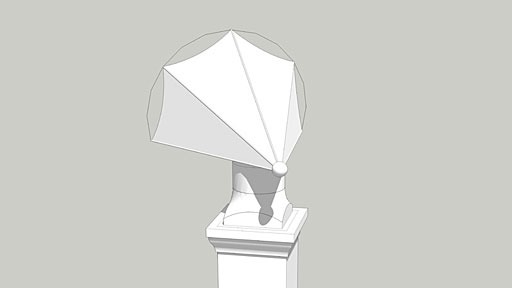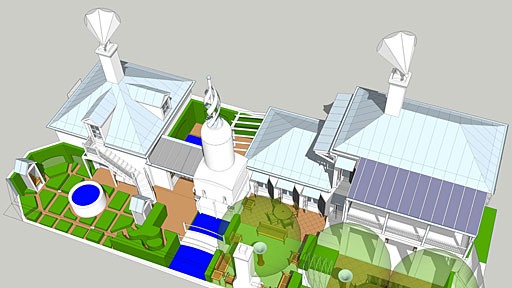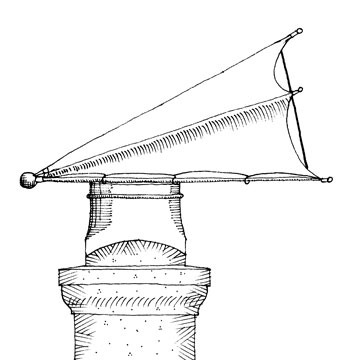search the Original Green Blog

There's much more to SmartDwelling I than the things I wrote about two years ago when it was published in the Wall Street Journal's Green House of the Future story. Really cool stuff is afoot with Project:SmartDwelling, so this will be the first of several new posts looking at SmartDwelling elements.

SmartDwelling I with the two breeze chimneys at the top

top view of Breeze Chimney
There are two Breeze Chimneys on SmartDwelling I, which was designed for the US Gulf Coast region. Because it's a land by the sea, I decided to use seafaring materials for the Breeze Chimneys. As we'll see in a moment, Breeze Chimneys in other parts of the country could be made out of other materials like sheet metal. The framework is built of small spars, like those which frame sails on sailboats. The spars could either be made of wood or fiberglass. The shroud is sail cloth stretched over the spars. This assembly is attached to a ring at the top of the chimney that rotates freely. Here's how it works:

section through Breeze Chimney showing air flow
The Breeze Chimney is designed to turn into the wind, like a weathervane. The open end of the Breeze Chimney is always leeward as a result. There's a phenomenon in physics known as the Venturi Effect, and it works like this: air moving past an opening tends to pull gases or liquids out of the opening. If you're old enough to remember cars before fuel injection, then it was the Venturi Effect that made the carburetors work.
Breeze chimneys behave the same way. They have another thing working for them as well: the Thermal Chimney Effect. Because hot air rises when given the opportunity, hot air in a tube like a chimney flue will rise out of the tube, pulling other air in behind it from the room below. To start a breeze chimney, all you need to do is to open a window somewhere in the house.


Pulling in air almost as warm as the air exhausted by the Breeze Chimney wouldn't do much good, so you need to find a window around the house or shop where the air is coolest.
The best place would be under a grove of trees or big shrubs. Not only do the leaves shade the area around the window, but they also cool the air even further by giving off water vapor. It can easily be 10-15 degrees cooler under a shady grove or in a thicket.
A louvered verandah like the ones found throughout the Bahamas would be good because the louvers prevent the sun from getting into the porch and warming it up. A porch on the shady side of the house would work equally well.
A breeze chimney works best in late afternoon or early evening, when the air has cooled a bit from the heat of the day. Porches on the eastern side of the building would be coolest at this time of day. There's no reason you have to use the same window, however… you could experiment to see what works best for you. But in any case, it's the act of opening the window that starts the Breeze Chimney's operation because without replacement air pulling into the house, the Breeze Chimney can't pull air out. So think of it as an attic fan that doesn't require any electricity.

side view of breeze chimney
What about storms? Wouldn't the sail cloth tear in high winds, flooding the house? Clearly, there needs to be some way of shutting the Breeze Chimney in a storm, or when you're going to be away from home for awhile. See the heavy black line on the right side of this drawing? It's meant to represent a spring metal arc that holds the spars up. There would be two cords coming down the chimney. Pull one of the cords, and that pulls the spring metal arc over to the left, collapsing the shroud. Pull the other one, and it pops back up. I haven't yet built a Breeze Chimney, so I'm sure it would require a bit of tinkering, but that's the general idea of how it should work.
The house above was designed for a competition we never expected to win. It was intended as a critique of the Gizmo Green competition program and, just as I expected, the jurors didn't view it very kindly. I'll blog more about it later… my point of showing it here is to illustrate how differently Breeze Chimneys can be designed.

This house was designed for Dallas. A century ago, you could find pivoting sheet metal roof vents all over the Midwest and Southwest. So I designed this Breeze Chimney to be built of the same material. There are only two differences between this Breeze Chimney and the old pivoting roof vents. First, it's a good bit larger than the old ones so it can ventilate the whole house. Second, the old pivoting roof vents usually vented the attic. In this design, there's a chimney (concealed by the roof) that connects the cap to the living spaces below.
~Steve Mouzon
More on SmartDwelling I:



